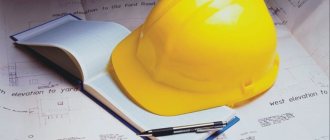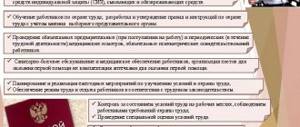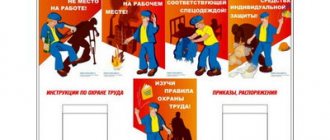Why is a labor safety commission created in an organization?
The creation of a labor safety commission is a procedure regulated by Art. 218 Labor Code of the Russian Federation. This commission can be formed voluntarily at the initiative of the employer, employees or trade union.
The corresponding internal corporate structure is designed to coordinate the joint actions of the employer company and employees aimed at ensuring the requirements of legislation in the field of labor protection, as well as the prevention of injuries at work and occupational diseases.
In addition, the commission checks the conditions in which employees work, and also informs them about the results of these checks. Another task of the labor protection committee (commission) is to collect proposals for the inclusion of certain standards in the collective agreement.
Who is on the commission?
The creation of a labor protection commission is regulated by labor legislation. Article 218 of the Labor Code states that the initiator can be:
- the employer himself;
- employees of the organization;
- representatives of a trade union or other representative body of the team.
Therefore, it must include representatives of the organization’s workforce, its management team and the trade union committee. Its number depends on the number of employees in the organization, as well as the structural units of the company and its other features.
As a rule, the head of the organization is elected as the chairman of the commission, and an employee of the labor protection service is appointed as the secretary. All its members must undergo appropriate training at least once every 3 years. They perform their duties during working hours and are paid in the usual manner.
Section 1: General Provisions
This section of the regulations on the labor safety commission includes language reflecting:
- that the regulation approved by the management of the employing company regulates the tasks, functions, and rights of the labor protection commission;
- that the committee created by the employer is an element of the occupational safety management system at the enterprise, as well as one of the internal corporate forms of employee participation in ensuring the operation of this system;
- that the committee created by the employer is designed to function on the basis of the principles of social partnership;
- that the commission interacts with regional authorities on labor protection issues, state supervisory authorities, as well as with competent trade union structures;
- that the commission in its work is guided by the provisions of legal acts at the federal and regional levels, industry and other agreements, local regulatory sources, and a collective agreement.
- that the commission is formed at the initiative of the employer company, employees or trade union, and its composition is represented by employees of the company and the trade union on a parity basis;
- how the size of the commission is determined, and how representatives of the employer, employees or trade union are appointed to its composition;
- the procedure for electing the chairman of the commission, his deputy, and the secretary of the commission;
- that the commission operates in accordance with the established regulations, as well as the plan, which are approved by the chairman;
- that commission members are required to undergo required employer-sponsored safety training;
- the procedure for reporting by the commission to a trade union or other competent organization about the work done;
- the procedure for changing representatives of the trade union and the employer on the commission.
About the composition
Who is on the commission? This circumstance plays an important role. In this regard, all issues should be regulated in the regulations.
Composition recommendations:
- It is imperative to include a person from the management team of the enterprise.
- An authorized representative from the trade union should also be included in the composition.
- Representative from a trade union organization.
It is important that the number of members is odd, since during the work controversial issues arise, the results of which are voted on. It turns out that the interests of all parties, without exception, are not ignored. Even if there is no trade union body, another employee can be included in the commission. Everyone will defend the interests of workers and have the right to vote.
Section 2: Tasks of the Commission
The main tasks of the labor protection commission, which must be reflected in the regulations:
- development of scenarios for joint actions of the employer company, trade union and other competent structures that are aimed at ensuring the requirements established in labor protection laws, preventing industrial injuries and occupational diseases;
- carrying out inspections of workplaces in the company, preparing analytical reports based on the results of relevant activities, sending proposals to the employer to optimize working conditions;
- interaction with the labor protection service established by the company in matters of informing employees about working conditions and safety, health risks, legally guaranteed compensation for work in harmful and dangerous conditions, and the use of personal protective equipment.
Section 3: Commission functions
The Ministry of Labor prescribes the following functions for the labor protection commission:
- studying proposals from the employer, employees or trade union to formulate recommendations for improving working conditions at the enterprise;
- assistance to the employing company in organizing occupational safety training and conducting briefings;
- participation in inspections of employee working conditions, development of recommendations for their improvement;
- providing employees with information about measures aimed at improving working conditions, preventing injuries at work, and occupational diseases;
- providing employees with information about the results of a special assessment of working conditions;
- providing employees with information about the standards for the supply of neutralizing substances, protective clothing, footwear, protective equipment, as well as their use;
- assistance to the occupational safety service in conducting medical examinations when hiring employees;
- assistance in providing employees with free milk and other food products required when working in hazardous conditions;
- assistance to the occupational safety service in considering aspects of financing activities in the field of occupational safety, implementing social insurance for employees, exercising control over the expenditure of corporate funds spent on the prevention of injuries at work and occupational diseases;
- assistance to the occupational safety service in improving production infrastructure, updating equipment on production lines in order to improve the safety of working conditions, as well as reduce working positions with hazardous working conditions;
- formation and submission to the employing company of proposals regarding the improvement of algorithms for carrying out work on labor protection and protection of the health of employees, the creation of mechanisms for rewarding employees who comply with labor safety requirements;
- formation and submission to the employer, trade union or other competent body of proposals regarding the preparation of draft local sources of standards in the field of labor protection.
Standard provision No. 412n
The standard document regulating the work of the occupational safety commission contains all the basic rules that define:
- general provisions;
- tasks;
- functions;
- rights.
Let's look at these sections in more detail.
General provisions
The section briefly outlines the regulatory basis for the creation of the commission and the purpose of its creation. Clarifies that it is an integral part of the occupational safety management system, and also works in close cooperation with the management of the organization, its staff, as well as the supervisory authorities of the constituent entities of the Russian Federation in the field of labor protection.
In its activities, the committee relies on the regulatory framework of the current legislation.
Tasks
The regulations should cover as fully as possible the tasks assigned to the commission. The standard provision contains the following:
- development of a program of joint activities of all structures of the organization and competent authorities aimed at complying with standards in the field of labor protection, as well as constantly working to prevent injuries and occupational diseases;
- regularly check the condition of production premises and places of work of workers, analyze the data obtained and make proposals to the employer aimed at improving working conditions;
- interact with the team, inform them about what risks they may be exposed to during the production process, what protection and compensation they are entitled to.
Functions
The standard provision recommends assigning the following functional responsibilities to the committee:
- constantly work on the issue of improving occupational safety in close cooperation with the manager, the team and the trade union, promote the training of workers and conduct briefings aimed at improving their knowledge in the field of labor protection;
- take an active part in workplace inspections, recommend the employer to introduce new, safer methods;
- inform the team about the activities carried out, the results of inspections, the results of workplace certification, standards for the provision of personal and collective protective equipment, and methods of their use;
- interaction with the occupational safety service regarding periodic medical examinations of workers, medical. examinations upon hiring, provision of dairy products to persons working in hazardous industries, consideration of financial issues for the implementation of measures aimed at occupational safety, introduction of modern production technologies;
- invite the employer to improve mechanisms in the field of labor protection by sending him relevant submissions;
- participate in the development of local acts of the organization in the field of occupational safety.
Rights
The assigned functions can only be performed if you have the appropriate rights, therefore the commission has the right to:
- be informed about working conditions, the presence of injuries at work and the incidence of occupational diseases, as well as the presence of dangerous and harmful factors and the risk for workers working under their influence;
- participate in committee meetings, where representatives of the employer and its structural divisions report on what measures are being taken for labor protection in the workplace, violations committed that entailed serious consequences, and propose penalties to the employer in accordance with current laws;
- make proposals for improving the collective agreement regarding occupational safety;
- invite employers to encourage activists who make innovative proposals to improve working conditions;
- take part in resolving labor disputes regarding labor safety.
Section 4: Commission Rights
In the internal corporate regulations on the labor safety commission, the Ministry of Labor also requires that its rights, presented in the following list, be recorded:
- the right to receive information from the labor safety service about conditions in the workplace, the prevention of injuries at work and occupational diseases, the presence of dangerous and harmful factors and measures to respond to them;
- the right to get acquainted with information from company representatives on labor protection issues at commission meetings;
- the right at commission meetings to get acquainted with information about violations of labor safety standards committed by employees, as well as to make proposals for responding to them;
- the right to participate in the formation of a collective agreement on labor safety;
- the right to submit proposals to the employer to reward employees for helping to improve working conditions;
- the right to assistance in resolving labor disputes in those areas regulated by labor safety legislation.
Results
The establishment of a labor safety commission is carried out at the initiative of the employer, employees or trade union. The activities of this commission must be regulated by a special regulation drawn up in a form approved by the Ministry of Labor of the Russian Federation.
You can get acquainted with the specifics of other tasks in the field of labor protection in the articles:
- “How is introductory training on labor protection carried out?”;
- “Frequency of testing knowledge on labor protection (nuances).”
You can find more complete information on the topic in ConsultantPlus. Free trial access to the system for 2 days.
your message
Recommendations for organizing a labor office and an occupational safety corner were approved by Resolution of the Ministry of Labor and Social Development of the Russian Federation dated January 17, 2001 N 7. The office and occupational safety corner are created in order to disseminate legal knowledge and carry out preventive work to prevent industrial injuries and occupational diseases. It is recommended to allocate a special room for the office, which is equipped with technical means, teaching aids and samples, illustrated and information materials on labor protection.
Another comment on Article 218 of the Labor Code of the Russian Federation









